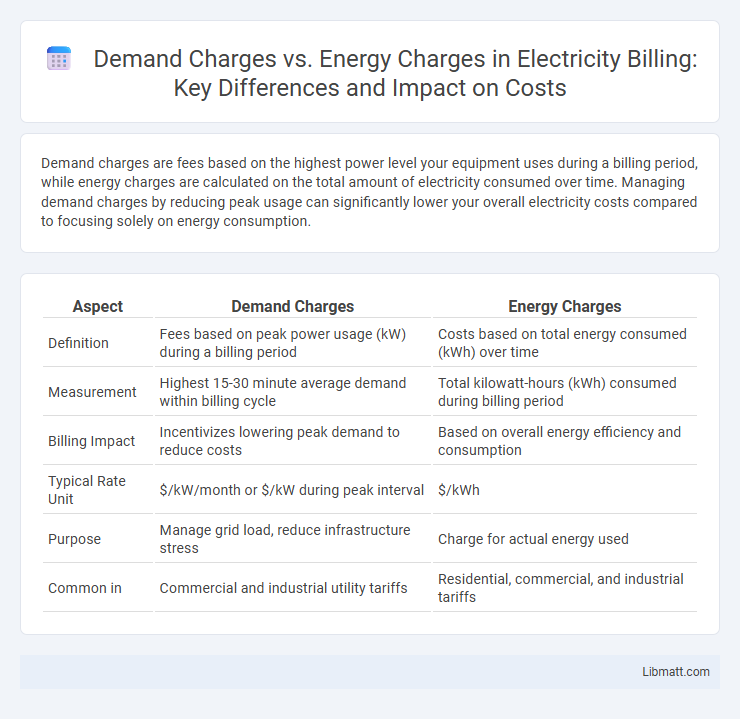Demand charges are fees based on the highest power level your equipment uses during a billing period, while energy charges are calculated on the total amount of electricity consumed over time. Managing demand charges by reducing peak usage can significantly lower your overall electricity costs compared to focusing solely on energy consumption.
Table of Comparison
| Aspect | Demand Charges | Energy Charges |
|---|---|---|
| Definition | Fees based on peak power usage (kW) during a billing period | Costs based on total energy consumed (kWh) over time |
| Measurement | Highest 15-30 minute average demand within billing cycle | Total kilowatt-hours (kWh) consumed during billing period |
| Billing Impact | Incentivizes lowering peak demand to reduce costs | Based on overall energy efficiency and consumption |
| Typical Rate Unit | $/kW/month or $/kW during peak interval | $/kWh |
| Purpose | Manage grid load, reduce infrastructure stress | Charge for actual energy used |
| Common in | Commercial and industrial utility tariffs | Residential, commercial, and industrial tariffs |
Understanding Demand Charges: Definition and Importance
Demand charges are fees based on the highest level of electrical power your facility draws during a specific time period, typically measured in kilowatts (kW). These charges reflect the cost to maintain capacity and ensure your electrical system can handle peak usage, making them a critical factor in your energy bill. Understanding demand charges helps you manage and reduce peak consumption, leading to more efficient energy use and cost savings.
What are Energy Charges? Core Concepts Explained
Energy charges refer to the cost billed based on the total amount of electricity consumed over a billing period, measured in kilowatt-hours (kWh). They account for the actual usage of electrical power and reflect the operating expenses of generating and delivering energy. These charges fluctuate with consumption volumes, making energy charges distinct from demand charges, which are tied to peak usage levels.
Key Differences Between Demand and Energy Charges
Demand charges are fees based on the peak power usage measured in kilowatts (kW) during a specific billing period, reflecting the highest level of electricity drawn at any moment. Energy charges are calculated on the total amount of electricity consumed over time, measured in kilowatt-hours (kWh), representing usage throughout the billing cycle. Key differences include demand charges targeting maximum power demand to manage grid strain, while energy charges target overall consumption, influencing usage patterns and cost management strategies.
How Utility Companies Calculate Demand Charges
Utility companies calculate demand charges based on the highest level of power (measured in kilowatts) a customer consumes during a specific time interval, usually 15 minutes to an hour, within the billing cycle. This peak demand reflects the maximum load the utility must supply, influencing infrastructure and capacity planning costs. Unlike energy charges that are calculated from the total kilowatt-hours consumed, demand charges specifically target the customer's peak usage, encouraging load management and reducing strain on the grid.
Factors Influencing Energy Charge Rates
Energy charge rates are primarily influenced by factors such as the cost of fuel, generation mix, and market demand fluctuations. Seasonal variations, regional grid constraints, and regulatory policies also play critical roles in determining these rates. Efficiency of power plants and the integration of renewable energy sources further impact the overall energy pricing structure.
Impact of Demand Charges on Business Electricity Bills
Demand charges significantly influence business electricity bills by billing based on the highest power usage during peak periods, often resulting in hefty costs during short bursts of high consumption. Unlike energy charges, which are calculated on total kilowatt-hours used, demand charges incentivize businesses to manage and reduce peak load to lower expenses. Understanding and controlling demand charges can help your business achieve substantial savings on monthly electricity costs.
Strategies to Reduce Demand Charges
Implementing load management techniques such as peak shaving and demand response can significantly reduce demand charges by lowering the highest power usage during peak periods. Utilizing energy storage systems like batteries allows for shifting energy consumption away from high-demand intervals, minimizing the demand charge impact. Optimizing equipment operation schedules and investing in energy-efficient technologies also contribute to flattening peak demand and decreasing overall electricity costs.
Monitoring and Managing Energy Usage Effectively
Monitoring energy usage through smart meters and real-time data analytics helps identify peak demand periods that drive demand charges, enabling targeted load reduction strategies. Effective energy management systems prioritize shifting consumption to off-peak hours to minimize demand charges while optimizing overall energy consumption and lowering energy charges. Utilizing demand response programs and automated controls further enhances the ability to control both demand and energy charges, ensuring cost-efficient operation.
Demand Charges vs Energy Charges: Case Studies and Examples
Demand charges are fees based on the highest level of power drawn during a billing period, while energy charges are calculated on the total kilowatt-hours consumed. Case studies from commercial buildings show that reducing peak demand through load management can significantly lower demand charges, often resulting in greater savings compared to reducing total energy use alone. For example, a manufacturing facility that installed demand response controls reduced its peak demand by 30%, cutting demand charges by 40%, whereas energy charges dropped by only 10%.
Future Trends in Utility Pricing: Demand and Energy Charges
Future utility pricing models are shifting towards more dynamic demand charges that reflect your peak electricity use, encouraging energy efficiency and load management. Energy charges, based on total consumption, will continue but with growing integration of time-of-use rates to better capture grid stress periods. Advances in smart metering and data analytics enable utilities to refine demand charges for more accurate cost allocation and incentivize sustainable energy behavior.
Demand charges vs Energy charges Infographic

 libmatt.com
libmatt.com